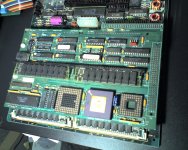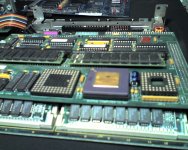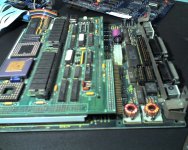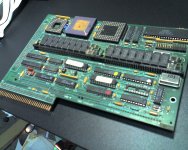I bought one of these and a Lapis DPD card for $23 last week, and there appears to be very little information about them out there. Looks like a 20 MHz 030 and 68882, with four RAM slots. But next to the CPU is another big socket of about the same size, and i can't guess what is supposed to be there. Maybe some other 68k support chip? Also I wonder about how much RAM this thing can use. I will guess it is no SE/30 but it probably improves upon the 4NB on board, else they would not have bothered. I can hardly wait to try it. Any SE gurus?
-
Updated 2023-07-12: Hello, Guest! Welcome back, and be sure to check out this follow-up post about our outage a week or so ago.
You are using an out of date browser. It may not display this or other websites correctly.
You should upgrade or use an alternative browser.
You should upgrade or use an alternative browser.
Quesse Total Systems PDS accelerator for SE
- Thread starter CJ_Miller
- Start date
Bunsen
Admin-Witchfinder-General
I think I know where this is going! Yes, I do - which I found on the side of the road. It is decent. I wonder whether the PCBs need to be directly placed or I can angle them up a little. Looks like I will need to find out! Also I am still annoyed that I bought a license for VueScan and the author refused to provide the OS 9 version. I got around it though.
Thank you for the (implied) tip, Comrade Doctor Bunsen! Can one upload images here? I don't recall seeing it done on 68kmla. Of course I will crop and compress to a decent size.
Thank you for the (implied) tip, Comrade Doctor Bunsen! Can one upload images here? I don't recall seeing it done on 68kmla. Of course I will crop and compress to a decent size.
madmax_2069
Well-known member
You could always upload the picture to a host and link it here using the tags or just a standard link.
Bunsen
Admin-Witchfinder-General
Nope. Scanners have a very narrow field of focus. Flat is best.or I can angle them up a little.
See under the text entry box on the Reply page, where it says "Upload attachment"?Can one upload images here?
It has been difficult to get any decent pictures of this nice pile of boards. The chips and connectors made them not flat enough for my scanner. Then I finally found my crappy old digital camera - but either it or its batteries are borked. So I photographed the stuff with my phone, and the results are not as detailed as I would like.
The Quesse upgrade was shipped to me attached to its host SE logic board. The blue card is a DPD card which was included, one of the connector pins is broken and will be replaced once I can find some here. The PCBs on the angled metal bit with the jacks are obviously the video output. The Quesse upgrade and Lapis DPD cards are both very bowed. The Quesse has a 40 MHz crystal on board and a 20 MHz 68030. The smaller socket next to it I am sure is for a 20 MHz 68882. But the other socket? There is another large socket to the left of the 030 with a different pinout, no idea what it is for. Under this board is a large socket which looks like it could drop into a 68000 socket, maybe an upgrade option for Macs without a PDS?
Nice deal, being basically a complete 030 computer for $21, needing only a disk drive, PSU, and monitor. I would be grateful if anybody can explain or point out more information about any of this stuff. I will try to post better pics when I can.




The Quesse upgrade was shipped to me attached to its host SE logic board. The blue card is a DPD card which was included, one of the connector pins is broken and will be replaced once I can find some here. The PCBs on the angled metal bit with the jacks are obviously the video output. The Quesse upgrade and Lapis DPD cards are both very bowed. The Quesse has a 40 MHz crystal on board and a 20 MHz 68030. The smaller socket next to it I am sure is for a 20 MHz 68882. But the other socket? There is another large socket to the left of the 030 with a different pinout, no idea what it is for. Under this board is a large socket which looks like it could drop into a 68000 socket, maybe an upgrade option for Macs without a PDS?
Nice deal, being basically a complete 030 computer for $21, needing only a disk drive, PSU, and monitor. I would be grateful if anybody can explain or point out more information about any of this stuff. I will try to post better pics when I can.




Temetka
Well-known member
I have nothing on the technical side of things to add.
However I love looking at pics of old hardware. I love how the sockets and chips look, the PCB wiring and so on. Todays tech boards just don't look as populated or badass as those pics you just posted.
My guess is the same as yours for the smaller socket: a 6882 FPU upgrade. The other socket I have no clue.
However I love looking at pics of old hardware. I love how the sockets and chips look, the PCB wiring and so on. Todays tech boards just don't look as populated or badass as those pics you just posted.
My guess is the same as yours for the smaller socket: a 6882 FPU upgrade. The other socket I have no clue.
I agree that there is something about the ceramic and gold of old ICs which screams "QUALITY!". A cheap computer-routed PCD with a few BGAs, or worse - blob chips - is hardly inspiring. I especially love funky VLSIs, like on my DECtalk card here. But my electric bill does mostly prefer the newer electronics.However I love looking at pics of old hardware. I love how the sockets and chips look, the PCB wiring and so on. Todays tech boards just don't look as populated or badass as those pics you just posted.
I doubt if it would be an additional processor, but perhaps an alternate one? I would like to compare the pins to a 68020, maybe it can use either. I would guess that the board would be much busier if it could handle two CPUs simultaneously.Could it be a socket for a second processor?
I tried doing scans again with adjustments for height, light, etc but no luck.
So I decided to install this stuff and test it out. The inside of my SE was easier to manage than i expected. The Quesse 030 upgrade easily fits on the logic board.
The Lapis DPD though, is impossible. The tolerances of it fitting look like they could barely happen, but trying for almost two hours I was unable to get them to fit. It is clever: On the back of the processor upgrade there is a 64 pin ribbon connector. This is a PDS passthrough. At the expansion slot, the video output jacks get screwed in from outside, fastened to a bracket and PCB on the inside. This PCB connects via the 64 pin ribbon to the 030, and has a regular PDS connector also. The Lapis display card fits to this second PDS and rests atop the floppy drives. The video output from the display card connects to the expansion port card via a 16 pin ribbon connector. Where it all doesn't quite fit for me is the 64 pin ribbon connector, there is simply not enough clearance between the logic board and chassis for it to fit there. I know it is an ugly fix, but if I dremel away a strip of metal it would fit without any problems. So I left the Lapis card out, as I haven't now an appropriate monitor anyway.
No fireworks! The system does appear to be accelerated. I don't see anything like a "System Profiler" so I don't really know what is happening in there. Memory still reads as 4 MB, but I don't know whether those are the SIMMs on the logic board or on the upgrade. I ran a few MIDI apps and those appear more responsive. Lastly I started MCL 2.0, which used to take about a minute to start previously, and instead started within a few seconds. I like it so far.
I will open it again soon once I obtain a FPU chip and show how it fits together. I am entertaining a perverse notion that if I don't find a dual page display, that I should hang the iisi NuBus adaptor out of the expansion slot instead. It would look interesting with my SampleCell strapped to its back!
So I decided to install this stuff and test it out. The inside of my SE was easier to manage than i expected. The Quesse 030 upgrade easily fits on the logic board.
The Lapis DPD though, is impossible. The tolerances of it fitting look like they could barely happen, but trying for almost two hours I was unable to get them to fit. It is clever: On the back of the processor upgrade there is a 64 pin ribbon connector. This is a PDS passthrough. At the expansion slot, the video output jacks get screwed in from outside, fastened to a bracket and PCB on the inside. This PCB connects via the 64 pin ribbon to the 030, and has a regular PDS connector also. The Lapis display card fits to this second PDS and rests atop the floppy drives. The video output from the display card connects to the expansion port card via a 16 pin ribbon connector. Where it all doesn't quite fit for me is the 64 pin ribbon connector, there is simply not enough clearance between the logic board and chassis for it to fit there. I know it is an ugly fix, but if I dremel away a strip of metal it would fit without any problems. So I left the Lapis card out, as I haven't now an appropriate monitor anyway.
No fireworks! The system does appear to be accelerated. I don't see anything like a "System Profiler" so I don't really know what is happening in there. Memory still reads as 4 MB, but I don't know whether those are the SIMMs on the logic board or on the upgrade. I ran a few MIDI apps and those appear more responsive. Lastly I started MCL 2.0, which used to take about a minute to start previously, and instead started within a few seconds. I like it so far.
I will open it again soon once I obtain a FPU chip and show how it fits together. I am entertaining a perverse notion that if I don't find a dual page display, that I should hang the iisi NuBus adaptor out of the expansion slot instead. It would look interesting with my SampleCell strapped to its back!
Bunsen
Admin-Witchfinder-General
Your third paragraph broke my brain a little. Is there both an SE PDS slot and an 030 PDS slot available, or does the Quesse board take up the SE PDS, and present an 030 PDS?? If the "passthrough" is an SE PDS, the IIsi Nubus adapter won't work (nor any other 030 PDS card).a 64 pin ribbon connector. This is a PDS passthrough.
I really do not know, at this stage. Do the PDS slots look any different? I need to compare what signals are present. My guess is that the second PDS is interfacing with the 030, so it is not really passing through to the same bus. For now I will get a pinout and when I open it again in a week or two try tracing the connections on the board.
Also I was up late working on both my SE and my SE/30 so my recollection is a bit jumbled.
Also I was up late working on both my SE and my SE/30 so my recollection is a bit jumbled.
jsarchibald
Well-known member
I got one of these in my recent mega haul. I have an MC68881 (FPU?) in the smaller socket where yours is empty, and the other is empty like yours. I also do not have that chip with 'LOGIC' on it either. Mounted on an SE mobo.
Trash80toHP_Mini
NIGHT STALKER
If that is, or is anything like, a Total Systems Gemini Accelerator for the SE, you're going to need the init/whatchamacallit OS level tweak to allow the SE to address the add'l Ram as Virtual Memory. IIRC, those cards could do something like 32 MB of RAM on the SE and, ISTR, they were available with either an '020 OR an '030 on board!
One of my NYMUG friends had a similar accelerator, possibly the Gemini, that's how I came by that bit of info about the VM scheme. That was his main machine until he bought a used Duo 230 & DuoDock, which I later bought from him to replace my PB100.
Is the Brand Name on a sticker or etched away with the traces on the PCB? The Gemini Accelerator was a brand name for a board from an OEM and available from other mail order houses as well. It was paired with either a Lapis Card for Grayscale or Panasonic's SE Interface Card for B&W. I've still got the manual and the NuBus card for my Panasonic 19" TPD.
What connector is on the Lapis Card? Panasonic's Single Bit NuBus Video Interface Card for the PanaPro M19M2 has a DB-9 connector. It's sitting in front of me, date etched on the card is 1988. I don't have the Monitor, it was lost in the Storage Room Disaster. I don't remember if it still worked and was retired when I finally got my first color monitor, a Radius 19" IntelliColorTPD, which did finally die. I held onto the Panasonic for retirement as a shallow depth TPD MacQuarium Hack.
That's all the info I can dredge up from my sleepy noggin or from the Magic Boxen™ after just one cup of coffee, I'm almost certain I've got tearsheets of the Total Systems ad in my files.
Gotta run right now, but check to see if your card is listed in the Accelerator Comparison Scans I may have added to the other article/advert scans that I've posted somewhere in the Peripherals Forum (?).
TTFN
edit: check for The Gauge Series in the Peripherals Links Project, that utility suite will do most everything the System Profiler can do and much more.
One of my NYMUG friends had a similar accelerator, possibly the Gemini, that's how I came by that bit of info about the VM scheme. That was his main machine until he bought a used Duo 230 & DuoDock, which I later bought from him to replace my PB100.
Is the Brand Name on a sticker or etched away with the traces on the PCB? The Gemini Accelerator was a brand name for a board from an OEM and available from other mail order houses as well. It was paired with either a Lapis Card for Grayscale or Panasonic's SE Interface Card for B&W. I've still got the manual and the NuBus card for my Panasonic 19" TPD.
What connector is on the Lapis Card? Panasonic's Single Bit NuBus Video Interface Card for the PanaPro M19M2 has a DB-9 connector. It's sitting in front of me, date etched on the card is 1988. I don't have the Monitor, it was lost in the Storage Room Disaster. I don't remember if it still worked and was retired when I finally got my first color monitor, a Radius 19" IntelliColorTPD, which did finally die. I held onto the Panasonic for retirement as a shallow depth TPD MacQuarium Hack.
That's all the info I can dredge up from my sleepy noggin or from the Magic Boxen™ after just one cup of coffee, I'm almost certain I've got tearsheets of the Total Systems ad in my files.
Gotta run right now, but check to see if your card is listed in the Accelerator Comparison Scans I may have added to the other article/advert scans that I've posted somewhere in the Peripherals Forum (?).
TTFN
edit: check for The Gauge Series in the Peripherals Links Project, that utility suite will do most everything the System Profiler can do and much more.
jsarchibald
Well-known member
I don't remember (or never knew) the size/pinout, but could the extra socket be for a PMMU chip? If the upgrade was designed to work with either a 68030 or a 68020, then they might have provided a socket for the PMMU, for the case where one is using the 68020. And naturally the socket would always be empty when using a 68030.
The PMMU would have been a 68851.
I find it interesting that jsarchibald's board is missing a forty pin chip and supporting chip next to it, but CJ's board has those two. CJ, what are the markings on the chip in the lower left corner? Forty pinners like that were often serial controllers (85C30), floppy controllers (SWIM or WD37C65), or SCSI controllers (53C80). No reason why an SE would need any of those though.
Perhaps this upgrade is meant to be usable in more than the SE, or versions built on the same circuit board... A 128KE or 512KE upgrade might benefit from having a SCSI chip on board.
The PMMU would have been a 68851.
I find it interesting that jsarchibald's board is missing a forty pin chip and supporting chip next to it, but CJ's board has those two. CJ, what are the markings on the chip in the lower left corner? Forty pinners like that were often serial controllers (85C30), floppy controllers (SWIM or WD37C65), or SCSI controllers (53C80). No reason why an SE would need any of those though.
Perhaps this upgrade is meant to be usable in more than the SE, or versions built on the same circuit board... A 128KE or 512KE upgrade might benefit from having a SCSI chip on board.
Similar threads
- Replies
- 14
- Views
- 553


